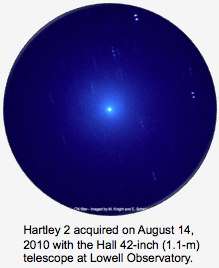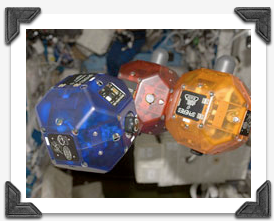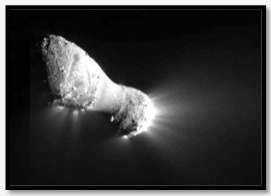 In one of its final mission trajectory correction maneuvers, the EPOXI mission spacecraft has refined its orbit, preparing it for the flyby of comet Hartley 2 on Nov. 4. The time of closest approach to the comet on that day is expected to be about 7:02 a.m. PDT.
In one of its final mission trajectory correction maneuvers, the EPOXI mission spacecraft has refined its orbit, preparing it for the flyby of comet Hartley 2 on Nov. 4. The time of closest approach to the comet on that day is expected to be about 7:02 a.m. PDT.
A Nov. 3 trajectory correction maneuver began at 11 a.m. PDT, when the spacecraft burned its engines for 60 seconds, changing its velocity by 1.59 meters per second.
On Nov. 4, the spacecraft will fly past Hartley 2 at a distance of about 700 kilometers (435 miles). It will be only the fifth time in history that a spacecraft has been close enough to image a comet’s nucleus.
EPOXI is an extended mission that uses the already “in-flight” Deep Impact spacecraft to explore distinct celestial targets of opportunity. The name EPOXI itself is a combination of the names for the two extended mission components: the extrasolar planet observations, called Extrasolar Planet Observations and Characterization (EPOCh); and the flyby of comet Hartley 2, called the Deep Impact Extended Investigation (DIXI). The spacecraft will continue to be referred to as “Deep Impact.”
For more information about EPOXI, visit the mission website.
Click here see some spectacular video about the EPOXI/Hartley 2 encounter.
Link to the NES Virtual Campus website.
 Two suitcases, called Passive Experiment Containers, containing 3 million basil seeds were attached to the outside of the International Space Station during a spacewalk. The suitcases were left there for one year as part of the MISSE, or Materials International Space Station Experiment. One PEC was attached to one of the high-pressure tanks around the Crew Lock and the other was located on the outboard end of the Quest Joint Airlock.
Two suitcases, called Passive Experiment Containers, containing 3 million basil seeds were attached to the outside of the International Space Station during a spacewalk. The suitcases were left there for one year as part of the MISSE, or Materials International Space Station Experiment. One PEC was attached to one of the high-pressure tanks around the Crew Lock and the other was located on the outboard end of the Quest Joint Airlock. Two suitcases, called Passive Experiment Containers, containing 3 million basil seeds were attached to the outside of the International Space Station during a spacewalk. The suitcases were left there for one year as part of the MISSE, or Materials International Space Station Experiment. One PEC was attached to one of the high-pressure tanks around the Crew Lock and the other was located on the outboard end of the Quest Joint Airlock.
Two suitcases, called Passive Experiment Containers, containing 3 million basil seeds were attached to the outside of the International Space Station during a spacewalk. The suitcases were left there for one year as part of the MISSE, or Materials International Space Station Experiment. One PEC was attached to one of the high-pressure tanks around the Crew Lock and the other was located on the outboard end of the Quest Joint Airlock.
 You won’t find any light sabers on the International Space Station, but you will find a trio of “droids” that look a lot like what any self-respecting science fiction fan remembers as a Star Wars “remote.”
That’s the tricky little device that Luke Skywalker used to hone his light-saber skills before he went up against Darth Vader and the rest of the Evil Empire.
But instead of being used for light-saber practice, the droids on the space station are being used to test automated rendezvous and formation flying in microgravity. And soon, there may be a host of other things the droids will be used to test, as their capabilities and uses are expanded and made available for National Laboratory and other uses.
You won’t find any light sabers on the International Space Station, but you will find a trio of “droids” that look a lot like what any self-respecting science fiction fan remembers as a Star Wars “remote.”
That’s the tricky little device that Luke Skywalker used to hone his light-saber skills before he went up against Darth Vader and the rest of the Evil Empire.
But instead of being used for light-saber practice, the droids on the space station are being used to test automated rendezvous and formation flying in microgravity. And soon, there may be a host of other things the droids will be used to test, as their capabilities and uses are expanded and made available for National Laboratory and other uses. During this episode of NASA Now, you’ll meet NASA physical scientist Lin Chambers, learn about the role of clouds in the Earth’s energy and water cycles, and find out how NASA collects cloud data. Understanding the impact of clouds is an important key to predicting how Earth’s climate may change in the future. Currently, five Earth observing satellites, known as the “A-Train” orbit the Earth. These satellites orbit in formation, following each other and barrel across the equator at about 1:30 p.m. local time each day. This behavior gives the constellation of satellites its name: The “A” stands for afternoon. By combining different sets of nearly simultaneous observations from these satellites, scientists are able to study important parameters related to climate.
During this episode of NASA Now, you’ll meet NASA physical scientist Lin Chambers, learn about the role of clouds in the Earth’s energy and water cycles, and find out how NASA collects cloud data. Understanding the impact of clouds is an important key to predicting how Earth’s climate may change in the future. Currently, five Earth observing satellites, known as the “A-Train” orbit the Earth. These satellites orbit in formation, following each other and barrel across the equator at about 1:30 p.m. local time each day. This behavior gives the constellation of satellites its name: The “A” stands for afternoon. By combining different sets of nearly simultaneous observations from these satellites, scientists are able to study important parameters related to climate.
 During this installment of NASA Now, NASA senior research engineer Judith Watson describes the project she’s currently working on. She’s one of a team of engineers at NASA’s Langley Research Center who are studying inflatable structures that might one day be used to establish an outpost on the moon or Mars.
During this installment of NASA Now, NASA senior research engineer Judith Watson describes the project she’s currently working on. She’s one of a team of engineers at NASA’s Langley Research Center who are studying inflatable structures that might one day be used to establish an outpost on the moon or Mars. Spaced Out Sports is a national student design challenge for students in grades 5-8. The purpose is for students to apply Newton’s Laws of Motion to designing or redesigning a game for International Space Station astronauts to play in space. As students design a new sport, they learn about Newton’s Laws of Motion and the effect of gravity on an object. They predict the difference between a game or activity played on Earth and in the microgravity environment of the ISS.
Spaced Out Sports is a national student design challenge for students in grades 5-8. The purpose is for students to apply Newton’s Laws of Motion to designing or redesigning a game for International Space Station astronauts to play in space. As students design a new sport, they learn about Newton’s Laws of Motion and the effect of gravity on an object. They predict the difference between a game or activity played on Earth and in the microgravity environment of the ISS. 
 Someday YOU may one of the people to walk around on Mars. That’s some day in the future — way in the future. But here’s your chance to have a presence on Mars soon! Send your name to Mars! Your name will be included with others on a microchip attached to the rover, Curiosity. Launch is scheduled for between Nov. 25 and Dec. 18, 2011, with a Martian arrival date of August 2012.
Someday YOU may one of the people to walk around on Mars. That’s some day in the future — way in the future. But here’s your chance to have a presence on Mars soon! Send your name to Mars! Your name will be included with others on a microchip attached to the rover, Curiosity. Launch is scheduled for between Nov. 25 and Dec. 18, 2011, with a Martian arrival date of August 2012. In one of its final mission trajectory correction maneuvers, the EPOXI mission spacecraft has refined its orbit, preparing it for the flyby of comet Hartley 2 on Nov. 4. The time of closest approach to the comet on that day is expected to be about 7:02 a.m. PDT.
In one of its final mission trajectory correction maneuvers, the EPOXI mission spacecraft has refined its orbit, preparing it for the flyby of comet Hartley 2 on Nov. 4. The time of closest approach to the comet on that day is expected to be about 7:02 a.m. PDT. During this unique episode of NASA Now, astronaut and veteran spacewalker Mike Foreman describes his experiences from liftoff to living and working in space.
During this unique episode of NASA Now, astronaut and veteran spacewalker Mike Foreman describes his experiences from liftoff to living and working in space.